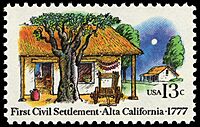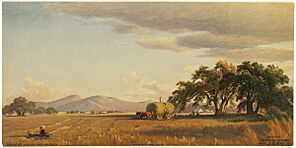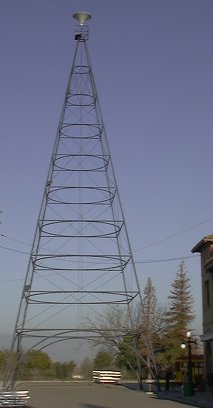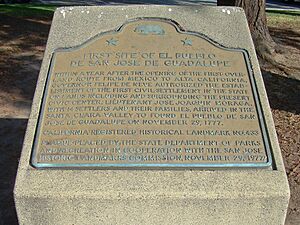History of San Jose, California facts for kids
Quick facts for kids History of San Jose, California |
|
|---|---|
| Lua error in Module:Location_map at line 420: attempt to index field 'wikibase' (a nil value). | |
| Location | San Jose, California |
| Official name: First Site of El Pueblo de San Jose de Guadalupe | |
| Designated | March 16, 1949 |
| Reference no. | 433 |
San Jose, California, is the third largest city in California. It is also the biggest city in the San Francisco Bay Area and Northern California, with over one million people living there.
Contents
Early Days: How San Jose Began
For thousands of years, the area that is now San Jose was home to several groups of Ohlone Native Americans. European settlers first arrived in California in 1770. They founded the Presidio of Monterey and Mission San Carlos Borromeo de Carmelo about 60 miles (100 km) south of San Jose.
Finding a Place to Settle
In 1775, Juan Bautista de Anza led an important trip. He brought colonists from New Spain (which is now Mexico) to California. His goal was to find good spots for new missions, a military fort (called a presidio), and a town (called a pueblo).
In 1776, Anza left the colonists in Monterey. He then explored north and chose the sites for the Presidio of San Francisco and Mission San Francisco de Asís in what is now San Francisco. On his way back, he picked the spots for Mission Santa Clara de Asís and the town of San Jose in the Santa Clara Valley. Anza returned to Mexico before these places were built, but his name is still remembered in many local places.
The Founding of San Jose
The town of El Pueblo de San José de Guadalupe (The Town of Saint Joseph of Guadalupe) was started on November 29, 1777. It was founded by José Joaquín Moraga. This was the very first town in upper Las Californias that was not connected to a mission or a military fort.
Mission Santa Clara was founded earlier in 1777, about three miles (5 km) from San Jose. Mission San José was built much later, in 1797, about 20 miles (30 km) north.
San Jose was founded as a farming community. Its main job was to grow food for the military forts in San Francisco and Monterey. In 1778, the town had 68 people. In 1781, new rules were made for how these towns should be run.
In 1797, the town moved from its first spot to where Downtown San Jose is today. It was built around Pueblo Plaza, which is now called Plaza de César Chávez. Over the years, many large land areas, known as Mexican Rancho Land Grants, were given out in what is now San Jose.
San Jose in the 1800s
Joining the United States
During the Bear Flag Revolt in 1846, Captain Thomas Fallon and his small group took over San Jose without a fight on July 11. Fallon raised an American flag over the town on July 14. This happened as California decided to join the United States during the Mexican–American War. Fallon later became the tenth mayor of San Jose.
The Gold Rush and Mercury Mines
During the California Gold Rush, the New Almaden Quicksilver Mines south of San Jose were very important. They were the biggest mercury mines in North America. Mercury was used to help separate gold from other materials.
The red rock (called cinnabar) that contains mercury was found in 1845. A Mexican cavalry captain, Andres Castillero, noticed local Ohlone Indians using the red powder to decorate a chapel. Mining started in 1847, just in time for the Gold Rush. The importance of mercury back then is why the local newspaper is still called the Mercury News.
California's First Capital
On March 27, 1850, San Jose became the first official city in California. Josiah Belden was its first mayor. San Jose also served as California's first state capital. The first two meetings of the California Legislature were held there in 1850 and 1851. However, the lawmakers were not happy with the location because there were no good buildings for the state government. They soon moved the capital to Benicia.
From 1858 to 1861, San Jose was a stop for the Butterfield Overland Mail stagecoach line.
The Electric Light Tower
In 1881, San Jose built a large San Jose Electric Light Tower to light up downtown. It was supposed to replace the gas streetlights that had been used since 1861. But the tower did not give off enough light. By 1884, it was only used for special events. It fell down during a big storm in 1915.
The Winchester Mystery House
In 1884, Sarah L. Winchester moved to San Jose. She was the widow of William Winchester, whose family made the famous Winchester rifle. Sarah began building a huge house that carpenters and craftsmen worked on until she died. The house was built continuously for 38 years. Before the 1906 San Francisco earthquake, the Winchester Mystery House was 7 stories tall. Today, it has three stories and about 160 rooms.
San Jose in the 1900s
Early Radio and World War II
In 1909, Dr. Charles Herrold started trying out radio broadcasts in downtown San Jose. His station got a commercial license in 1921 as KQW. It later moved to San Francisco and became KCBS in 1949.
During World War II, San Jose saw some challenges. Many Japanese American families were forced to leave their homes and live in special camps during the war. Also, many African Americans moved to San Jose from the Southern states to work in the city's growing factories during this time.
Political Changes
For a long time, San Jose was a politically conservative city. But in the 1980s, things began to change. As the city grew and became more urban, its politics started to look more like other big cities. Today, San Jose mostly votes for the Democratic party.
San Jose in the 2000s
Recent Events
On May 26, 2021, a sad event happened at a train yard in San Jose. A shooting took place, and ten people, including the shooter, lost their lives.
San Jose recovered faster from the COVID-19 pandemic than San Francisco and Oakland. By 2023, many stores were moving from San Francisco to the Westfield Valley Fair mall in San Jose. San Jose's mayor, Matt Mahan, even joked that the "San Francisco Bay Area" might one day be called the "San Jose Bay Area" because San Jose had become the largest and most successful city.
Earthquakes in San Jose
San Jose is located near several active faults, which are cracks in the Earth's crust. These include the Monte Vista Fault, Hayward Fault Zone, Calaveras Fault, Silver Creek Fault, and the famous San Andreas Fault.
Many earthquakes have been felt in San Jose over the years, including big ones in 1856, 1868, 1906, and 1989. The 1906 San Francisco earthquake caused a lot of damage in San Jose. The all-brick Agnews Asylum (now Agnews State Hospital) was destroyed, and over 100 people died. The three-story stone and brick San Jose High School also fell down. Many other buildings were badly damaged. Most earthquake damage is quickly fixed, but sometimes you can still see cracked sidewalks or raised curbs.
From Farms to Technology: San Jose's Big Change
For almost 200 years, San Jose was a farming community. It grew a lot of fruits and vegetables until the 1960s. Many team names, street names, and buildings still remind us of its farming past. Prunes, grapes, and apricots were some of the main crops. In 1922, the first commercial farming of broccoli in the U.S. started in San Jose.
The Del Monte cannery in Midtown was the city's largest employer for many years. There were so many orchards in the Santa Clara Valley that the area was nicknamed The Valley of Heart's Delight. The smell of ripening fruit was wonderful.
Food Machinery Corporation (FMC) started nearby in 1884 and moved to San Jose in 1903. During World War II, FMC began making military vehicles. After the war, FMC continued to be a defense contractor, designing and building military equipment like the M113 Armored Personnel Carrier and the Bradley Fighting Vehicle.
The Rise of Silicon Valley
IBM started its first operations on the West Coast in San Jose in 1943. In 1952, they opened a research lab downtown. Here, Reynold Johnson and his team invented RAMAC, an early type of computer storage. In 1956, IBM opened a factory where disc drives were invented in 1962. IBM later moved its research to other large facilities in the Coyote Valley and the Almaden Research Center.
By the 1970s, much of the farmland was gone. The Valley of Heart's Delight had changed into Silicon Valley, a famous center for technology.
How San Jose Grew
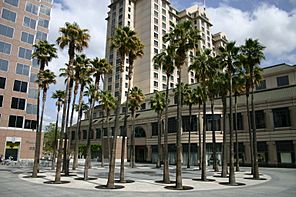
A. P. Hamann, also known as "Dutch," became the city manager in 1950. At that time, San Jose had about 95,000 people and was only 17 square miles (44 km2). Hamann started a plan to make the city grow quickly by adding nearby areas like Alviso. He also encouraged building new homes and businesses spread out across the area. Hamann traveled a lot to convince companies to move to San Jose.
Because of Hamann's efforts, San Jose's population grew by more than eight percent each year. When he left office in 1969, San Jose had grown to 495,000 people and covered 136 square miles (352 km2).
However, this fast growth caused problems. The city had a lot of debt, and public services like schools, fire, and police were struggling. People started to push back against this uncontrolled growth. In the late 1960s, several people who wanted to slow growth were elected to the City Council. Hamann retired. In 1971, Norman Mineta became mayor. He and others on the City Council worked to manage growth better. In 1974, Janet Gray Hayes was elected mayor, continuing this focus.
Since then, San Jose has focused on managing its growth. It set an "urban service area" to guide where new buildings could go. It also limited building in the eastern hills and delayed growth in the Coyote Valley. To the west, towns like Campbell and Cupertino became their own cities to avoid being added to San Jose. The city also made new rules for planning and made sure new buildings paid for the services they would need.
Even with these rules, San Jose continued to grow. As the electronics industry, especially personal computers and integrated circuits, boomed, San Jose's population kept rising fast. By 1980, the city had over 629,000 people. By 1990, it had over 782,000. Because of many new jobs and people moving in, housing costs in San Jose and the rest of the Bay Area grew much faster than the national average. Between 1976 and 2001, San Jose's housing costs went up by 936%, the fastest growth in the country.
In August 1989, San Jose became larger than San Francisco in population for the first time. San Jose is now the biggest city in the San Francisco Bay Area.
In the early 1990s, San Jose was sometimes criticized for its growth. In response, the city has tried to build more homes and businesses within its existing developed areas. In 1994, the city council approved a plan that kept its original growth boundaries. In 1998, voters said no to a plan that would have allowed more building in the hills. Since 1980, most new homes in San Jose have been apartments or condos, showing the city's focus on smart growth.
Landmark Status
On March 16, 1949, the First Site of El Pueblo de San Jose de Guadalupe was named a California historical landmark. A special plaque there says: "Within a year after the opening of the first overland route from Mexico to Alta California, Governor Felipe de Neve authorized establishment of California's first civil settlement. Lieutenant José Joaquín Moraga arrived in the Santa Clara Valley with 14 settlers and their families on November 29, 1777 to found El Pueblo de San José de Guadalupe near the present civic center."


